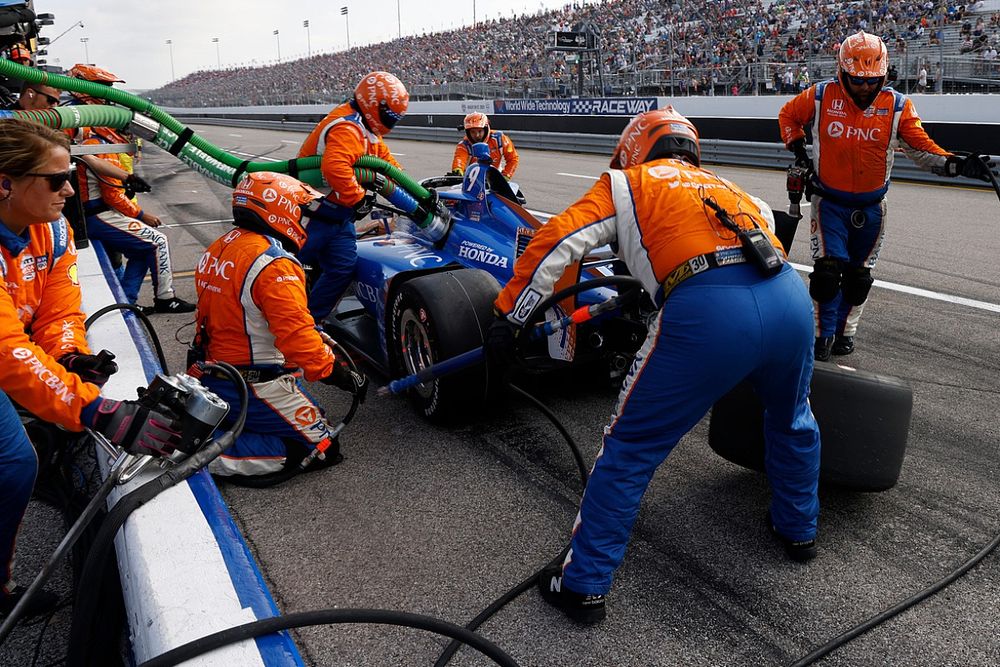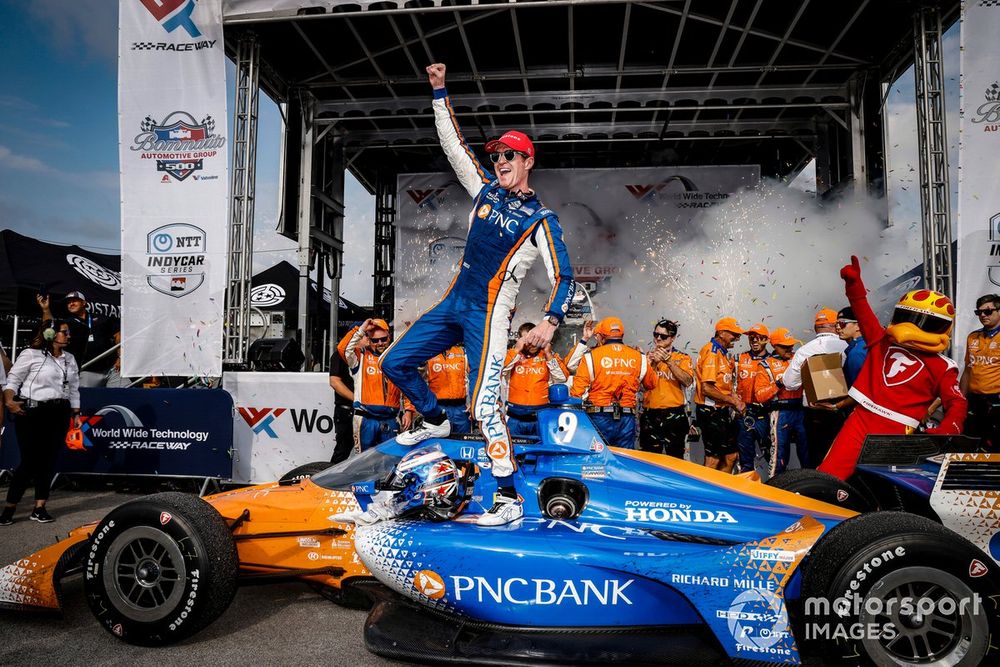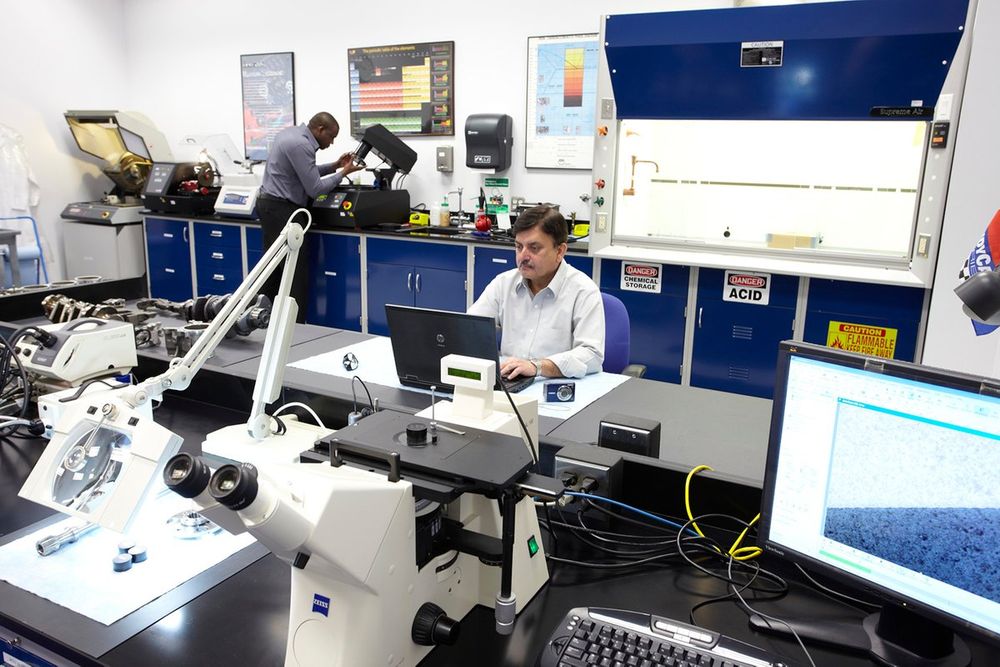IndyCar fuel save secrets explained: The science behind Dixon’s magic
Scott Dixon has produced two of the greatest comeback performances in recent IndyCar Series history at the Indianapolis Road Course and the St Louis oval. So how does he do it, time and again, and at such different venues?

At Indy, a stack-up crash – ironically caused by his younger Chip Ganassi Racing team-mates – led to him being punted from behind and spinning onto the infield grass on the opening lap. No bother, he pitted under the yellow, got rid of his least-preferred tire, and split the remaining distance into two stops.
With his rivals ahead all three-stopping, he knew that hitting his fuel number with stable lap times were the keys to the comeback, and he beat Graham Rahal – who’d absolutely hosed everyone else that day – by half a second.
When asked for his secret to saving fuel, he replied: “Lifting. I don't know, man. I would say Honda. I was actually shocked, just the pace that we had.
“The car just kept doing the same lap times, mid-73s to 74-flats. The fuel mileage, huge credit to Honda and HPD, it was remarkably easy to get.
“I thought only the Hondas could make it from that point [his first stop with 80 laps remaining]. I didn't think the other manufacturer could do it. That was a good thing for us.”

Scott Dixon, Chip Ganassi Racing Honda, podium
Photo by: Michael L. Levitt / Motorsport Images
At St Louis last weekend, he made a three-stop strategy work when nobody else could, and most of his rivals ended up stopping five times. Again, he had to work his way to the front, after an engine change grid penalty dropped him to 16th. Again, he won – this time by the best part of a lap!
Of course, “lifting” and adjusting his braking points is his expertise but how about the other side of the coin – Honda? Its American racing president is David Salters, whose previous life was in Formula 1 working for Mercedes, Ferrari and Cosworth, has seen many brilliant drivers at close quarters, and he has nothing but high praise for the six-time IndyCar champion.
“It’s a pleasure for us to watch him do it,” says Salters. “Motor racing is a team sport, the driver is at the pointy end and he’s a very smart and fast driver and it makes a difference, and then there’s a whole group of people behind him bevering away on the chassis and powertrain.
“Scott is so calm and rational, and that goes a long way. He has such a strong team, there’s some amazing talent at the Ganassi organization. They know how to work a problem by being smart.
“In terms of fuel saving, the ultimate goal is to make the engine more efficient. But you always want maximum power, so how do you do that for the minimum amount of fuel? Anyone can save fuel, but as you can see with Scott, the real key is not losing lap time.
“Having the mental capacity as you do that, because you change the operating window of the car, so lifting early and braking later means there’s less energy going into the tires – it’s a very complex system.
“There’s this amazing superhuman person who’s not only driving a car at 180mph but he’s busy changing his lift and braking points meter by meter, lap by lap, and he has to adapt to the car. Someone like Scott, he’s one of the greats in IndyCar with all those championships, and what he keeps doing is mind-boggling. He’s fast but with the mental capacity to think ahead.
“The champions are like that, and you can hear it on his radio. And it’s like he’s almost sat on the pit stand – although in truth he’s far away from it in the cockpit.”

Assembly section, Honda Performance Development
Photo by: Honda Performance Development
Here comes the science bit…
Honda Performance Development’s 123,000-square-foot facility in Santa Clarita produces all of its IndyCar engines. But it’s a production line with a twist, being a research and development facility that is constantly striving to improve its performance and its fuel mileage.
“The engine has many different settings, so you have maximum performance that is no compromise with everything optimised, all the calibration parameters,” says Salters. “But then we put a lot of time and effort into finding islands of performance that have the minimum impact on power but start to save fuel. So, in straightforward terms, you go leaner.
“But when you go leaner, how do you reoptimize the engine? We’re all greedy, we want power and fuel economy. I often speak to our drivers, and ask them what they want, and they reply they want both of those and drivability. And on the car, they want maximum grip for no drag, simple!
“There’s been lots of good learning about getting maximum efficiency from running leaner, Formula 1 started a whole trend in this direction. But racing engine methodology has always been about max power versus max efficiency, so you need to focus on both without compromising neither – which is easier said than done.
“As you develop your engine, you’re always thinking about how you can help both.”

Scott Dixon, Chip Ganassi Racing Honda logo
Photo by: Michael L. Levitt / Motorsport Images
So what are the key areas that HPD constantly evolves to keep ahead of its friends at Ilmor, who produce the Chevrolet engine?
Salters explains: “Compression ratio in an engine improves its efficiency, which is good, but then you become knock-limited, the engine wants to detonate. Over the years we’ve found clever combustion ways to get around that. There’s a huge amount of simulation, we use a single-cylinder research engine where you can visualise and measure everything. It comes down to a lot of hard work.
“What gives me more power? What gives me more economy? As you go lean, how do you ensure the combustion is still the best it can be? And just as importantly, where should the driver use it around the track? That’s where he comes into it.
“It’s an engineering exercise. You go leaner, you will lose performance, but how can you minimise that loss by what you do with the race car? We do a lot of lap time simulation with the teams, including the DIL [driver in loop], and we try and optimize that side of it.
“That’s where we work in harmony with the team, the driver and the race car. The really good drivers seem to have an inbuilt, machine-learning algorithm! They learn where to lift, to save the fuel, that has minimal impact.”

Analysis lab, Honda Performance Development
Photo by: Honda Performance Development
We’re back to Dixon again! Another aspect to consider is IndyCar’s new fuel for 2023. It consists of a blend of second-generation ethanol, derived from sugarcane waste and other biofuels, to create a fuel that is 100% comprised of feedstocks categorized as ‘renewable’.
“We had a new fuel, so that’s been an opportunity,” says Salters. “When anything changes, you look to maximise that, can I get there quicker than my competitor? Everyone always catches up but the way to get ahead is really smart people with really smart tools. As computers and science have got better, you can correlate the models – they’ll tell you anything, it’s knowing how wrong they are.
“For every gram of fuel in your tank, you want to burn it quickly and efficiently without waste. Effective compression ratio, cam timings, all that stuff has been well documented for years but what has changed is combustion modelling – that’s altered a lot in the last 10 years.
“You can very effectively model the combustion, which is quite complicated, all the air motion that goes in there, then you have to mix the fuel, so you’ve got so-called two-phase flow. As the fuel and air mixes, it’s all turbulent, and then you need to do all the chemical kinetics to model the chain reactions that happen in the combustion.”

Helio Castroneves, Meyer Shank Racing Honda, HPD Engineer
Photo by: Michael L. Levitt / Motorsport Images
Honda supplies 15 cars in the series and each of its teams gets an embedded engineer, not only to deal with any issues they encounter with the engine, but also working on optimizing the performance side.
“We have a pre-event report, which goes out to all our teams, where we run a lot of lap time simulation,” says Salters. “Whatever we’ve changed in terms of optimizing the engine, all the sensitivities are communicated to the teams, like the different mixture positions on the steering wheel. So we do that, the teams will also independently do their own stuff, and then it’s up to them how to use the powertrain in the car at each race.
“We have all our engineers that are embedded within the teams, they work hand-in-hand with the engineers, drivers and strategists on the pit stand. It’s not just the fuel save stuff, we have qually mode and push mode, all sorts of modes! They bring all the information to the teams.”
The final part of the equation is having the confidence – and knowledge – of how far you can push your gas window to make these frugal strategies work. And that’s been one of the keys to Dixon’s success, in both of his recent successes he’s been able to cruise back to Victory Lane, so there’s clearly been a margin factored in too.

Scott Dixon, Chip Ganassi Racing Honda
Photo by: Josh Tons / Motorsport Images
Knowing your engine’s exact operating parameters is vital, as Salters explains: “Before it leaves the factory, the flow characteristics of injectors are different, so we run them through fuel rigs. You want to get down to your last drop of available energy.
“Measurements are made in the ECU, so we know how much fuel the engine is using – and because each engine we put in our cars is slightly different, we’re at the level that we need to know every slight variance, and then throughout the weekend they work on something called fuel meter error, which checks our estimations through the ECU and what actually happens.
“We try to compensate for fuel temperature, engine temps and vibration levels and all that type of stuff, but they can change a little bit. It’s never quite as precise as you’d like it to be, and then we’ll recalibrate stuff and it’ll all be different again! A lot of effort goes on at our factory and at the racetrack to estimate the fuel we use.
“There is a final warning system, as all the tanks have collectors, so you know when the fuel is finished in the tank because the collector sends a signal. It’s a process because you don’t want to run the car out of fuel.”
And not running out of fuel has been the crux of Dixon’s comeback in the IndyCar points table as well, although his team-mate Alex Palou is expected to clinch that this weekend in Portland.
That will make eight titles between them, but even Palou admits he’s in awe of Dixon when it comes to being king of the fuel save…
Related video
Subscribe and access Motorsport.com with your ad-blocker.
From Formula 1 to MotoGP we report straight from the paddock because we love our sport, just like you. In order to keep delivering our expert journalism, our website uses advertising. Still, we want to give you the opportunity to enjoy an ad-free and tracker-free website and to continue using your adblocker.



















